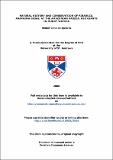Files in this item
Natural history and conservation of pirarucu, Àrapaima gigas', at the Amazonian Várzea : red giants in muddy waters
Item metadata
| dc.contributor.advisor | Magurran, Anne E. | |
| dc.contributor.author | Queiroz, Helder Lima de | |
| dc.coverage.spatial | 250 | en_US |
| dc.date.accessioned | 2012-06-20T09:59:48Z | |
| dc.date.available | 2012-06-20T09:59:48Z | |
| dc.date.issued | 2000 | |
| dc.identifier | uk.bl.ethos.538446 | |
| dc.identifier.uri | https://hdl.handle.net/10023/2818 | |
| dc.description.abstract | The pirarucu, Arapaima gigas (Osteoglossidae, Teleostei), an important natural resource in the Amazonian flooded forest, has been exploited for centuries and is now threatened by overfishing. The aim of this thesis, therefore, is to investigate the biology and ecology of this species so that sustainable management programmes can be put in place and the conservation of this fish ensured. Most of the research was carried out at Mamiraua Reserve, a protected area of Varzea forest in the Central Brazilian Amazon. Additional data were also recorded at the aquarium of the Amazonian Museum of Natural History, at Manaus, Brazil. A study of the main environmental aspects varzea aquatic systems, showed that the lakes at Mamiraua Reserve could be grouped into two main categories based on their limnological morphological features. The investigation of the fisheries management by local fishermen revealed that the use of traditional fishing technology was responsible for the maintenance of local stocks. However, recent technological changes had increased CPUE to alarming level. The analysis of pirarucu feeding habits demonstrated that pirarucus are specialised carnivores, living mainly on fishes. Other invertebrate species are also important in their diet. High degrees of food selectivity and strong seasonal changes in diet proved to be the most important factor affecting the seasonal growth of pirarucus. Pirarucu growth was examined by analysing the growth marks deposited on scales twice a year, at times of high ingestion of food. L was circa 2.5.m and k was about 0.18. No significant differences in growth patterns between the sexes were found. Ten cohorts or annual age classes were identified. These ranged from 0.80m to 2.25m in total length. Very high annual growth rates during the first years are replaced by moderate rates after the age of first sexual maturation. Maturity is reached when pirarucus are around 5 years of age, or about 1.65m in total length. Fecundity increases with age of females, and so does oocyte diameter. However, fecundity is divided between 4 to 6 clutches of gametes that can be used throughout the breeding season. Each clutch is spawned separately, in small batches with less than 500 eggs in average. This strategy probably protects pirarucu against the unpredictability of the environment and avoids reproductive failures - total loss of fertilised eggs - due to catastrophic events. By spawning eggs in separate batches pairs may breed again if the first attempt was not successful. Males perform parental care, protecting the nest and guarding the offspring for about 6 months. The typical red coloration of pirarucus is particularly evident in males after sexual maturation. Almost 70% of male body surface may be covered in bright red pigmentation, brighter than among females. It is proposed that red coloration signals the size and/or age of pirarucus, and is used in the context of sexual selection. Male-male competition and female choice of males are likely to be operating in this species. The information in this thesis leads to several recommendations for the conservation of pirarucus. Criteria for selection of lakes in a rotational system of fisheries management, and age-specific impact of fishing and natural mortality rates on the stock are major topics discussed. The aim is the maximisation of breeding stock and local natural recruitment. Pirarucu farming and large scale conservation actions are also considered. Suggestions for future research on the biology of conservation of pirarucus are made. | en_US |
| dc.language.iso | en | en_US |
| dc.publisher | University of St Andrews | |
| dc.rights | Creative Commons Attribution-NonCommercial-NoDerivs 3.0 Unported | |
| dc.rights.uri | http://creativecommons.org/licenses/by-nc-nd/3.0/ | |
| dc.subject.lcc | QL638.O88Q4 | |
| dc.title | Natural history and conservation of pirarucu, Àrapaima gigas', at the Amazonian Várzea : red giants in muddy waters | en_US |
| dc.type | Thesis | en_US |
| dc.type.qualificationlevel | Doctoral | en_US |
| dc.type.qualificationname | PhD Doctor of Philosophy | en_US |
| dc.publisher.institution | The University of St Andrews | en_US |
This item appears in the following Collection(s)
Except where otherwise noted within the work, this item's licence for re-use is described as Creative Commons Attribution-NonCommercial-NoDerivs 3.0 Unported
Items in the St Andrews Research Repository are protected by copyright, with all rights reserved, unless otherwise indicated.


